The New Family
Humans are social creatures, seeking interaction with their families and their societies. We have already seen how crucial social support is during pregnancy; social interaction may become even more important once the child is born.
The Newborn
Before birth, developing humans already affect their families through fetal movements and hormones that trigger maternal nurturance (food aversions, increased sleep, and more). At birth, a newborn’s appearance (big hairless head, tiny toes, and so on) stirs the human heart, evident in adults’ brain activity and heart rate. Fathers are often enraptured by their scraggly newborn and protective of the exhausted mothers, who may appreciate their husbands more than before, for hormonal as well as practical reasons.
VISUALIZING DEVELOPMENT
A Healthy Newborn
Just moments after birth, babies are administered their very first test. The APGAR score is an assessement tool used by doctors and nurses to determine whether a newborn requires any medical intervention. It tests five specific criteria of health, and the medical professional assigns a score of 0, 1, or 2 for each category. A perfect score of 10 is rare—
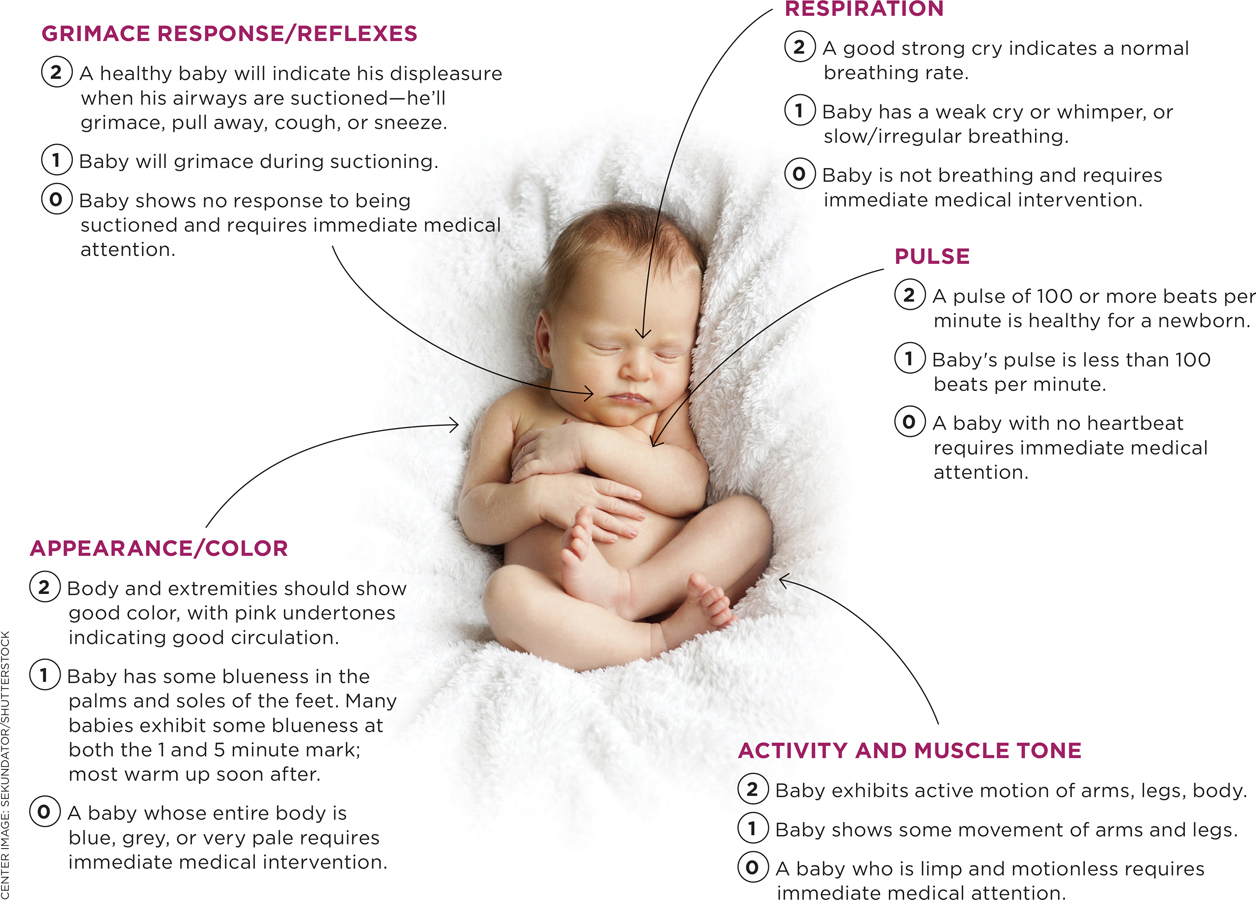
REFLEXES IN INFANTS
Never underestimate the power of a reflex. For developmentalists, newborn reflexes are mechanisms for survival, indicators of brain maturation, and vestiges of evolutionary history. For parents, they are mostly delightful and sometimes amazing.

Newborns are likewise responsive social creatures in the first hours of life (Zeifman, 2013). They listen, stare, cry, stop crying, and cuddle. In the first day or two, a professional might administer the Brazelton Neonatal Behavioral Assessment Scale (NBAS), which records 46 behaviors, including 20 reflexes. Parents who watch the NBAS are often amazed—
Technically, a reflex is an involuntary response to a particular stimulus. Humans of every age instinctively protect themselves (the eye blink is an example). That definition makes reflexes seem automatic. Not quite true. Actually, the strength and reliability of newborn reflexes varies depending on genes, drugs in the bloodstream, and overall health. (See Visualizing Development, p. 126.)
Reflexes that maintain oxygen supply. The breathing reflex begins even before the umbilical cord, with its supply of oxygen, is cut. Additional reflexes that maintain oxygen are reflexive hiccups and sneezes, as well as thrashing (moving the arms and legs about) to escape something that covers the face.
Reflexes that maintain constant body temperature. When infants are cold, they cry, shiver, and tuck their legs close to their bodies. When they are hot, they try to push away blankets and then stay still.
Reflexes that manage feeding. The sucking reflex causes newborns to suck anything that touches their lips—
fingers, toes, blankets, and rattles, as well as natural and artificial nipples of various textures and shapes. In the rooting reflex, babies turn their mouths toward anything that brushes against their cheeks— a reflexive search for a nipple— and start to suck. Swallowing also aids feeding, as does crying when the stomach is empty and spitting up when too much is swallowed quickly.
Other reflexes are not necessary for survival but signify the state of brain and body functions. Among them are the:
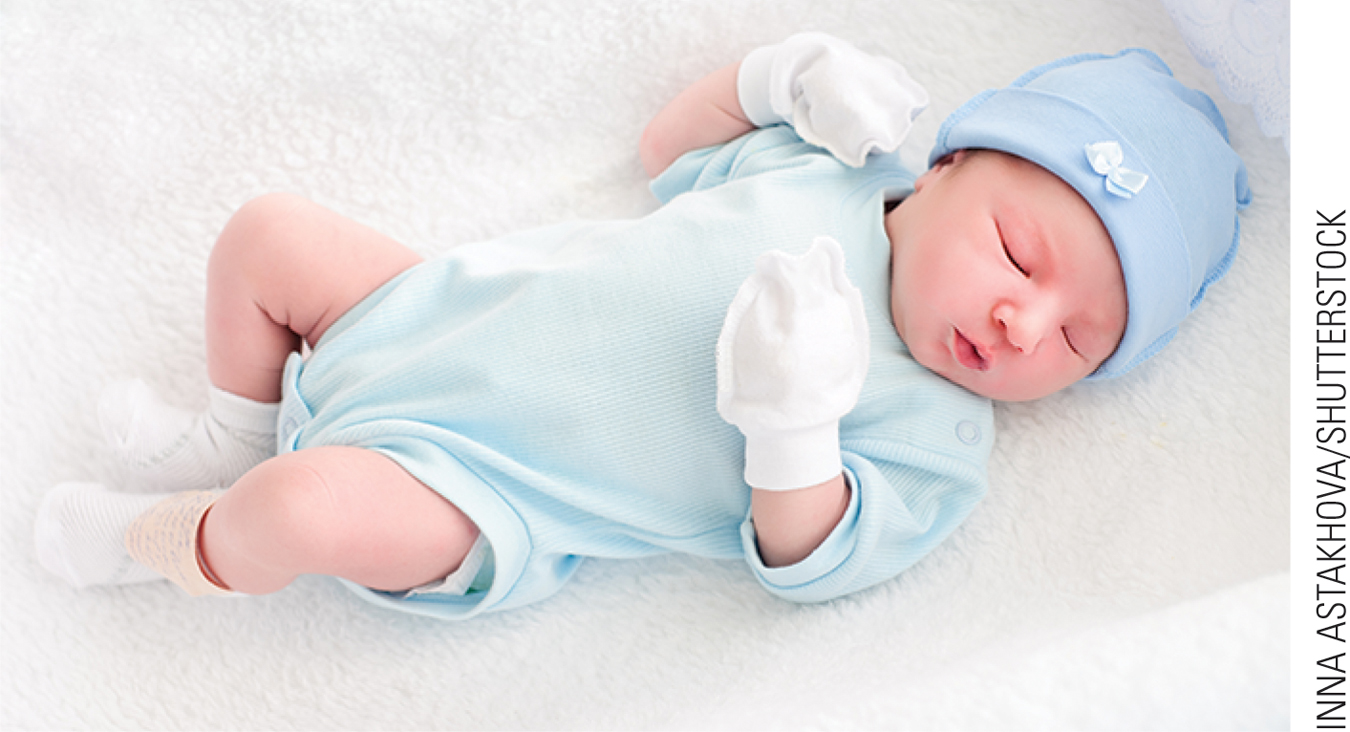

Video: Newborn Reflexes shows several infants displaying the reflexes discussed in this section.
Babinski reflex. When a newborn’s feet are stroked, the toes fan upward.
Stepping reflex. When newborns are held upright, feet touching a flat surface, they move their legs as if to walk.
Swimming reflex. When held horizontally on their stomachs, newborns stretch out their arms and legs.
Palmar grasping reflex. When something touches newborns’ palms, they grip it tightly.
Moro reflex. When someone bangs on the table they are lying on, newborns fling their arms outward and then bring them together on their chests, crying with wide-
open eyes.
These reflexes are responses to experiences, not unlike an adult’s sudden fear, or lust, or anger.
The senses are also responsive: New babies listen more to voices than to traffic, for instance. Thus, in many ways, newborns connect with the people of their world, who are predisposed to respond (Zeifman, 2013). If the baby performing these actions on the Brazelton NBAS were your own, you would be proud and amazed; that is part of being human.
New Mothers
About half of all women experience significant physical problems soon after birth, such as healing from a c-
With postpartum depression, baby care (feeding, diapering, bathing) feels very burdensome. The newborn’s cry may not compel the mother to carry and nurse her infant. Instead, the mother may have thoughts of neglecting or abusing the infant, thoughts so terrifying that she is afraid of herself.
The first sign that something is amiss may be euphoria after birth. A new mother may be unable to sleep, or to stop talking, or to push aside irrational worries. Some of this behavior is normal, but family members and medical personnel need to be alert to the mother’s emotions. After the initial high, severe depression may set in, with a long-
Especially for Nurses in Obstetrics Can the father be of any practical help in the birth process?
Usually not, unless he is experienced, well taught, or has expert guidance. But his presence provides emotional support for the woman, which makes the birth process easier and healthier for mother and baby.
But postpartum depression is not due to hormonal changes alone. From a developmental perspective, some causes of postpartum depression (such as financial stress) predate the pregnancy; others (such as marital problems) occur during pregnancy; others correlate with birth (especially if the mother is alone and imagined a different birth than actually occurred); and still others are specific to the particular infant (such as health, feeding, or sleeping problems). Successful breast-
New Fathers
As we have seen, fathers-
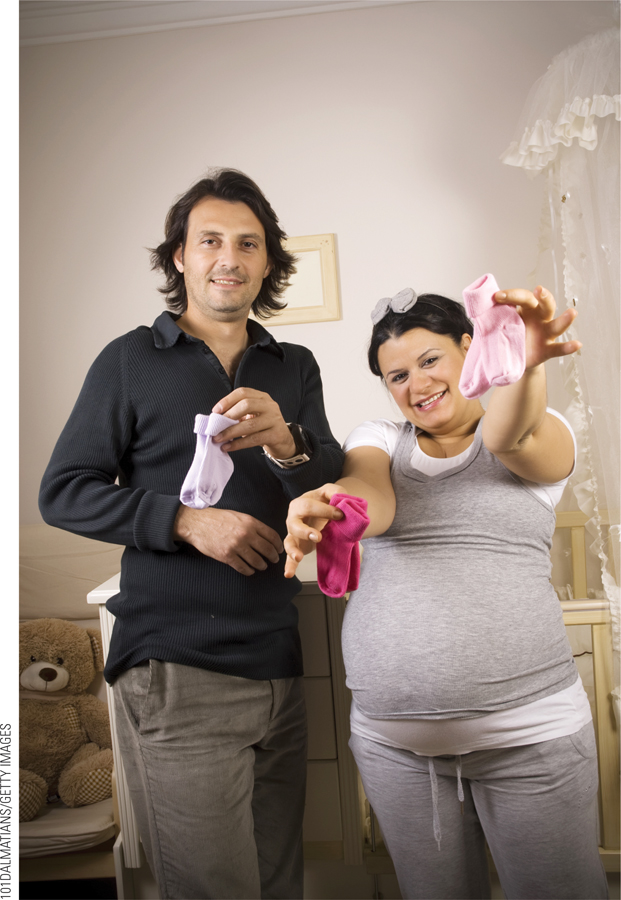
Being There
At birth, the father’s presence reduces complications, in part because he reassures his wife. I observed this when my daughter, Elissa, birthed Asa (now 5, as noted in the opening of this chapter). Asa’s birth took much longer than his younger brother’s; Elissa’s anxiety rose when the doctor and midwife discussed a possible cesarean for “failure to progress” without asking her opinion. Her husband told her, “All you need to do is relax between contractions and push when a contraction comes. I will do the rest.” She listened. He did. No cesarean.
Whether or not he is present at the birth, the father’s legal acceptance of the birth is important to mother and newborn. A study of all live, single births in Milwaukee from 1993 to 2006 (151,869 babies!) found that complications correlated with several expected variables (e.g., maternal cigarette smoking) and one unexpected one—
Currently, about half of all U.S. women are not married when their baby is born (Monte & Ellis, 2014), but fathers are usually listed. When fathers acknowledge their role, birth is better for mother and child.
Couvade
Fathers may experience pregnancy and birth biologically, not just psychologically with stress, worry, and so on. Many fathers have symptoms of pregnancy and birth, including weight gain and indigestion during pregnancy and pain during labor (Leavitt, 2009). Among the Papua in New Guinea and the Basques in Spain, husbands used to build a hut when birth was imminent and then lie down to writhe in mock labor (Klein, 1991).
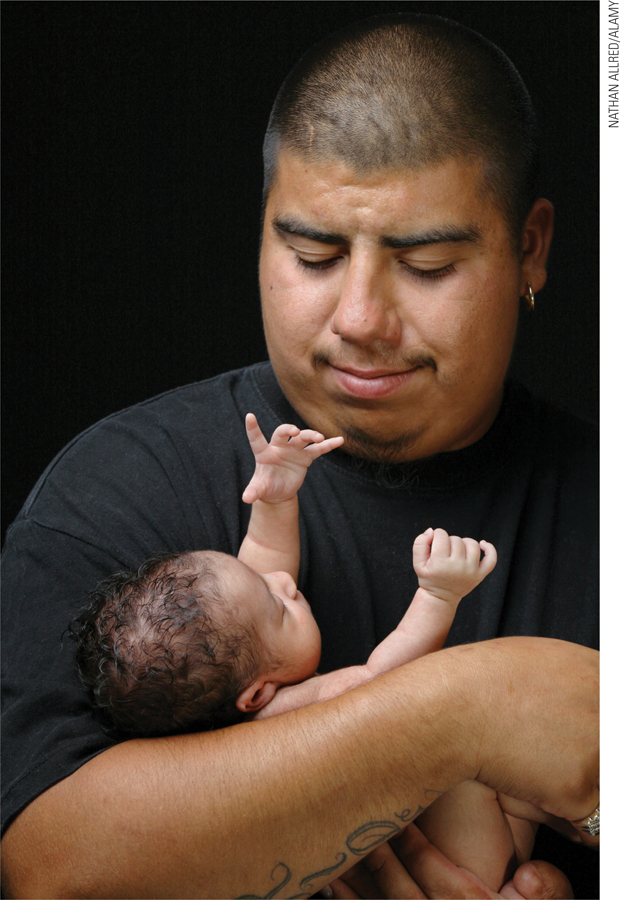
Paternal experiences of pregnancy and birth are called couvade—expected in some cultures, normal in many, and considered pathological in others (M. Sloan, 2009). A recent study in India found that most new fathers experienced couvade (Ganapathy, 2014). In the United States, couvade is unnoticed and unstudied, but many fathers are intensely involved with their future child (Brennan et al., 2007; Raeburn, 2014).
Fathers are usually the first responders when the mother experiences postpartum depression; they may be instrumental in getting the support the mother and baby need (Cuijpers et al., 2010; Goodman & Gotlib, 2002). But fathers are vulnerable to depression, too; other people need to help. Indeed, sometimes the father experiences more problems than the mother (Bradley & Slade, 2011).
Parental Alliance
Remember John and Martha, the young couple whose amniocentesis revealed that their fetus had trisomy-
“Scared of what?” he said. “Of a little baby who’s not as perfect as you think he ought to be?”
“I didn’t say I wanted him to be perfect,” I said. “I just want him to be normal. That’s all I want. Just normal.”
“That is total bullshit…. You don’t want this baby to be normal. You’d throw him in a dumpster if he just turned out to be normal. What you really want is for him to be superhuman.”
“For your information,” I said in my most acid tone, “I was the one who decided to keep this baby, even though he’s got Down’s. You were the one who wanted to throw him in a dumpster.”
“How would you know?” John’s voice was still gaining volume. “You never asked me what I wanted, did you? No. You never even asked me.”
[Beck, 1999, p. 255]
This episode ended well, with a long, warm, and honest conversation between the two prospective parents. Each learned what their fetus meant to the other, a taboo topic until that night. Adam, their future son, became an important part of their relationship.
Their lack of communication up to this point, and the sudden eruption of unexpressed emotions, is not unusual, because pregnancy itself raises memories from childhood and fears about the future. Yet honest and intimate communication is crucial throughout pregnancy, birth, and child rearing. Such early communication between new parents helps to form a parental alliance, a commitment by both parents to cooperate in raising their child.
The parental alliance is especially beneficial when the infant is physically vulnerable, such as having a low birthweight. The converse is also true: Family conflict when a newborn needs extra care increases the risk of child maladjustment and parental divorce (Whiteside-
Family Bonding
To what extent are the first hours after birth crucial for the parent-
However, the hypothesis that early skin-
This finding does not contradict the generalization that prospective parents’ active involvement in pregnancy, birth, and care of the newborn benefits all three. Factors that encourage parents (biological or adoptive) to nurture their newborns may have lifelong benefits (Champagne & Curley, 2010).
The role of early contact has become apparent with kangaroo care, in which the newborn lies between the mother’s breasts, skin-
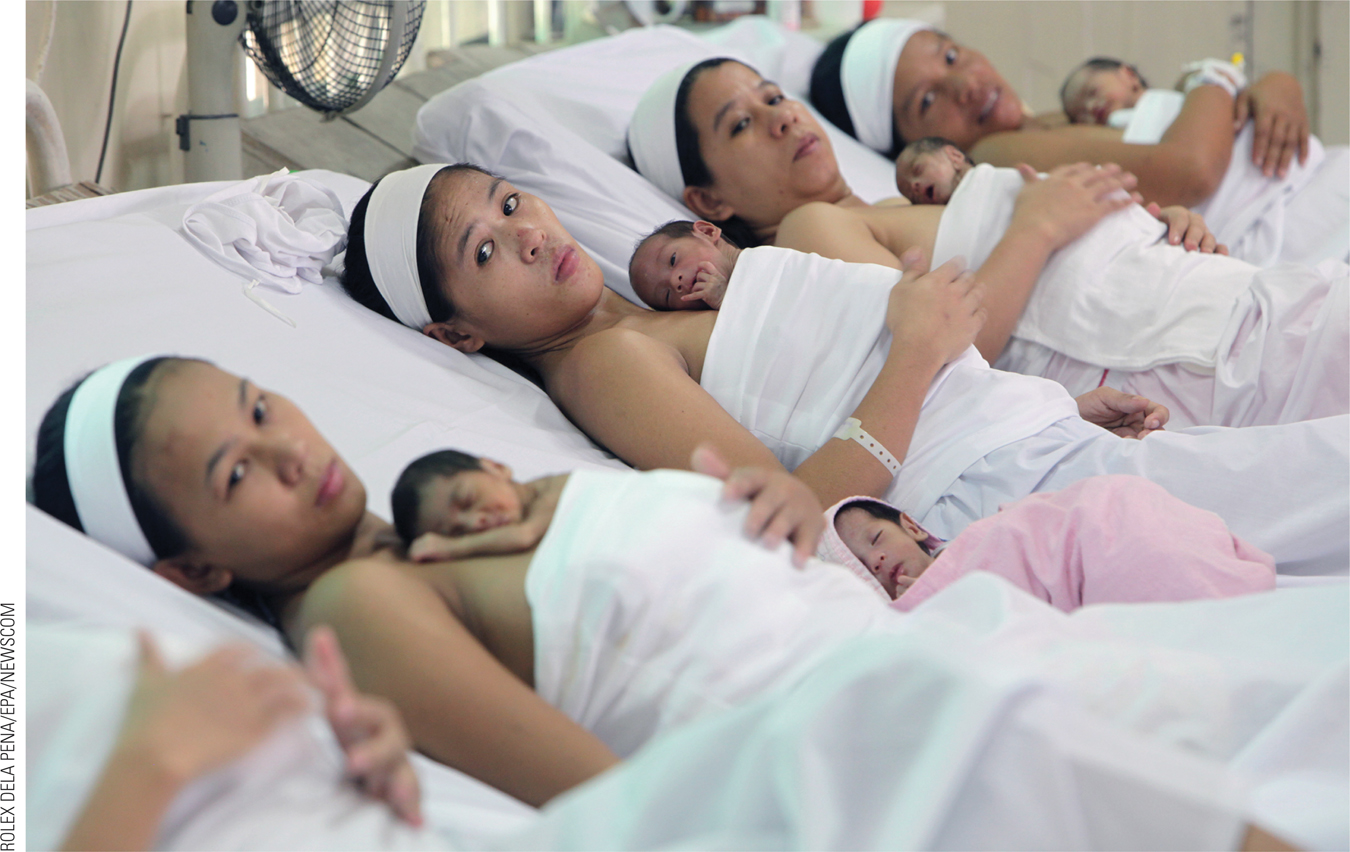
Kangaroo care benefits babies, not only in the hospital but months later, either because of improved infant adjustment to life outside the womb or because of increased parental sensitivity and effectiveness. Which of these two is the explanation? Probably both.
Implementation of many strategies, especially for fragile infants and their parents, is especially needed in developing nations, where kangaroo care and other measures could reduce deaths by 20 to 40 percent (Bhutta et al., 2008). From a developmental perspective, the most difficult time for high-
SUMMING UP Every member of the new family contributes to their shared connection, enabling them all to thrive. The new baby has responsive senses and many reflexes. Close observation and reflection reveal how much the new baby can do. The father’s support increases the likelihood of a healthy, happy newborn and mother. Postpartum depression of the mother is not rare; factors before and after birth affect how serious and long-
WHAT HAVE YOU LEARNED?
Question 4.23
What do newborns do to aid their survival?
Newborns exhibit reflexes that maintain their oxygen supply, body temperature, and manage feeding.Question 4.24
What impact do fathers have during and after birth?
At birth, the father's presence reduces complications, in part because his presence helps the mother during the birthing process. After birth, a father's support of the new family is crucial, sometimes being the reason for a healthy, happy newborn and mother. From a developmental perspective, some causes of postpartum depression (such as financial stress or marital problems) predate the pregnancy; others occur during pregnancy (especially if the woman is worried about the fetus or birth process); others correlate with birth (especially if the mother is unprepared, alone, or surrounded with unsupportive medical professionals); and still others are specific to the particular infant (health, feeding, or sleeping problems).Question 4.25
How do fathers experience pregnancy?
Many fathers experience biological symptoms of pregnancy and birth along with their partners. For example, levels of stress hormones correlate between expectant fathers and mothers. Many fathers experience weight gain and indigestion during pregnancy and pain during labor. Paternal experiences of pregnancy and birth are called couvade.Question 4.26
What are the signs of postpartum depression?
Sometimes the first sign is that the new mother seems euphoric after birth—unable to sleep, stop talking, or keep from worrying. A crash might follow the high. Overwhelmed by sadness and feelings of inadequacy, a mother suffering from postpartum depression may have trouble caring for her newborn. Question 4.27
What affects the parent–
infant bond? The parent–infant bond is the strong, loving connection that forms as parents hold, examine, and feed their newborn. It has been claimed that this bond develops in the first hours after birth when a mother touches her naked baby, just as sheep and goats must immediately smell and nuzzle their newborns if they are to nurture them. While research does not find that early skin– to– skin contact is essential for humans, mother– newborn interaction should be encouraged, although the parent– infant bond depends on many factors in addition to birth practices. Question 4.28
What are the results of kangaroo care?
Many studies find that kangaroo–care newborns sleep more deeply, gain weight more quickly, and spend more time alert than do infants with standard care. Infants who experience kangaroo care may adjust to life outside the womb better, and parents who use the method may have increased sensitivity and effectiveness in dealing with the newborn's needs.